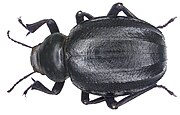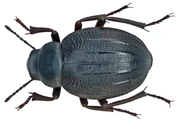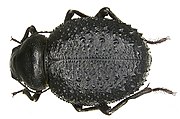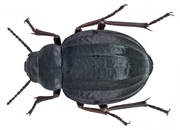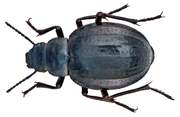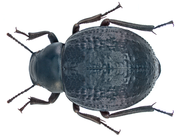
Darkling beetle is the common name for members of the beetle family Tenebrionidae, comprising over 20,000 species in a cosmopolitan distribution.

The Tenebrionoidea are a very large and diverse superfamily of beetles. It generally corresponds to the Heteromera of earlier authors.

Anthia is a genus of the ground beetle family (Carabidae) from Africa and Asia. Species of Anthia can spray a jet of formic acid up to 30 centimetres (12 in), which, if not treated, can cause blindness in animals that harass the beetles.

Cicindela, commonly known as common tiger beetles, are generally brightly colored and metallic beetles, often with some sort of patterning of ivory or cream-colored markings. They are most abundant and diverse in habitats very often near bodies of water with sandy or occasionally clay soils; they can be found along rivers, sea and lake shores, sand dunes, around dry lakebeds, on clay banks, or woodland paths.

Eleodes is a genus of darkling beetles, in the family Tenebrionidae. They are endemic to western North America ranging from southern Canada to central Mexico with many species found along the Mexico-United States border. Some species have been introduced to Colombia. The name pinacate is Mexican Spanish, derived from the Nahuatl (Aztec) name for the insect, pinacatl, which translates as "black beetle."

Tenebrioninae is the largest subfamily of the darkling beetles (Tenebrionidae), containing flour beetles, among others. Tenebrioninae contains more than 20 tribes.

Melyridae are a family of beetles of the superfamily Cleroidea.
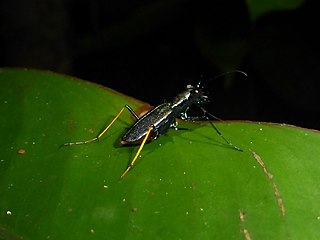
Odontocheila is a genus in the beetle family Cicindelidae. There are more than 70 described species in Odontocheila, found in South America, Central America, and Mexico.

Gonocephalum is a genus of darkling beetles in the family Tenebrionidae.

The Sepidiini is a tribe of ground-dwelling darkling beetles (Tenebrionidae), that occurs across Africa, the Mediterranean Basin, the Arabian Peninsula and Mesopotamia. It is composed of many hundreds of species. The larvae of some species are known to damage crops.
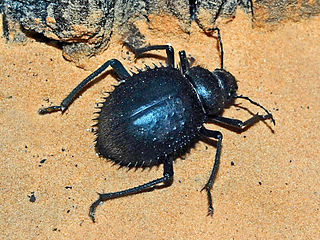
Pimelia angulata is a species of darkling beetles in the subfamily Pimeliinae.

Tribolium is a genus of flour beetles in the family Tenebrionidae. They are known by various common names including flour beetles, flour weevils, red weevils and bran bugs.
Toktokkies are various species of beetles that belong to the large Tenebrionidae family, also known as Darkling beetle. Toktokkies do not belong to a particular tribe or genus of Tenebrionids, but rather a selection of flightless species that make distinct noises by tapping on the ground with the abdomen. The Tenebrionidae family to which these beetles belong is quite large, with almost 3,500 species inhabiting Southern Africa. Nearly 200 species of Toktokkies inhabit the Namibia and 20 have adapted to the extreme temperatures of the Namib Desert. The most common Toktokkies in the Namib Desert are the Fog Basking beetle and the button beetle or trench-digging beetle.
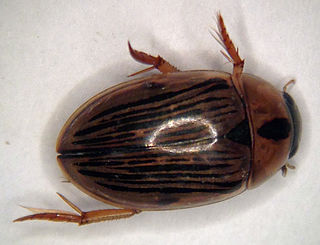
Tropisternus is a genus of hydrophilid beetles with 63 species in five subgenera in North and South America.
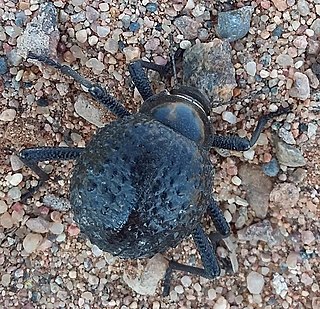
Physosterna cribripes, the desert toktokkie or woestyntoktokkie, is a flightless species of desert-dwelling darkling beetle or Tenebrionid found along the West coast of Namibia and Angola. This species has a body length of some 18.4 mm and a mass of 402 mg.

Lycinae is a subfamily of net-winged beetles in the family Lycidae.

Blaps is a genus of darkling beetles in the family Tenebrionidae. There are more than 30 described species in Blaps, the genus being most commonly found in Eurasia and Australia, with occasional sightings elsewhere in the world.

Pimeliini is a tribe of darkling beetles in the subfamily Pimeliinae of the family Tenebrionidae. There are more than 60 genera in Pimeliini, found primarily in the Palearctic.

Mariazofia is a genus of ground-dwelling Afrotropical beetles in the family Tenebrionidae. They are among the largest of the darkling beetles. Like other genera within subtribe Molurina, adults of this genus engage in a behavior known as "substrate tapping", a form of sexual communication in which they produce vibrations by tapping their abdomen rhythmically on the ground to attract mates. Their common name, "tok-tok beetle" or "toktokkie beetle", is based on this behavior.




